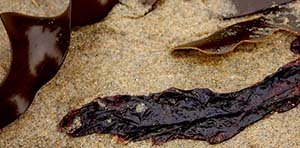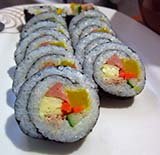Nori seaweed Nutrition facts
Nori seaweed is the most common edible seaweed produced worldwide. An eye-catching deep purple sushi roll you must have seen in any Japanese restaurant is actually the red nori algae that grows proficiently in the intertidal sea zones in many temperate areas around the world.
fScientific name: Porphyra spp., Rhodophyceae.
The characteristic red color of this algae is a result of excessive amounts of phycoerythrin pigment which outstrips the other pigments like phytocyanin, chlorophyll-A, β-carotene, and a number of photosynthetic biliproteins (phycobilins).
 |
| Raw nori seaweed with kombu. (Photo courtesy: Simon Huntley) |
Nori is the Japanese name for purplish lever. Japan, the Republic of Korea, and China are the chief commercial producers of this seaweed. Nori features a very thin, flat, purplish blade, and therefore, preferred in sushi rolls.
Cultivation
Porphyra species are commercially grown in seaweed farms where shorelines emerge above seawater during low tides but submerge again at high tide times. The long rope lines are arranged in the ocean in such a way that they are allowed to come out of the water so as to be exposed to the atmospheric air for a few hours a day. The Porphyra spores germinate on the ropes and grow into a new thallus (blade).
Each brownish-red thallus (frond) is composed of a one-cell layer of flat, broad, elliptical blades that generally grow up to 15-20 cm long.
Raw, wet Porphyra thus collected either by hand or using machines is further processed into dried sheets of nori in the processing units. During processing, most salt is washed away, so that the sodium content of prepared nori is low.
Dried and cut sheets are packed in bundles and dispatched to the markets for sale. A simple, dried, un-toasted product is called hoshi-nori, which distinguishes it from yaki-nori, which is toasted.
Health Benefits of Nori seaweed
Nori tops the list of seaweeds with the healthiest nutrition profile. It holds just 35 calories per 100 grams.
It composes sugars and fats in low percentages but has a high content of minerals, and vitamins, with significant amounts of vitamins A, vitamin C, and B-complex groups; and minerals like iodine, manganese, phosphorus, and iron.
It is among the most nutritious seaweeds with easily digestible and bio-available protein content ranging from 10-15 percent.
Nori and other red algae carry ample amounts of vitamin-A. 100 g of fresh, raw nori contains astoundingly 5,202 IU or 1734 % of daily recommended levels of vitamin A. Further, vitamin A is required for maintaining healthy mucosa and skin and is essential for night vision. Consumption of natural vegetables and fruits rich in vitamin A and flavonoids is also known to help the body protect from lung and oral cancers.
Laver (red algae) also contains good amounts of many B-complex vitamins such as vitamin-B6 (pyridoxine)-12% of RDA, riboflavin-34% of RDA, folates-39% of RDA, thiamin, and niacin. Folates in the diet help prevent neural tube defects in newborns.
100 g of fresh nori seaweed has 39 mg or 65% of daily recommended levels of vitamin C . However, drying and toasting greatly reduce its shelf-life. Vitamin C is a powerful antioxidant, which helps the body develop resistance against infectious agents and scavenge harmful oxygen-free radicals.
It is also an important vegetable source of EPA (20:5 n-3, eicosapantonoic acid), a omega-3 fatty acid.
The characteristic flavor of nori seaweed is attributed to the large amounts of three amino acids: alanine, glutamic acid, and glycine.
| Principle | Nutrient Value | Percent of RDA |
|---|---|---|
| Energy | 35 Kcal | 2% |
| Carbohydrates | 5.11 g | 4% |
| Protein | 5.81 g | 10% |
| Total Fat | 0.28 g | 1% |
| Cholesterol | 0 mg | 0% |
| Dietary Fiber | 0.3 g | 1% |
| Vitamins | ||
| Folates | 146 μg | 36% |
| Niacin | 1.470 mg | 9% |
| Pyridoxine | 0.159 mg | 12% |
| Riboflavin | 0.446 mg | 34% |
| Thiamin | 0.098 mg | 8% |
| Vitamin-A | 5202 IU | 1734% |
| Vitamin-C | 39 mg | 65% |
| Vitamin-E | 1 mg | 7% |
| Vitamin-K | 4 mg | 3% | Electrolytes |
| Sodium | 48 mg | 3% |
| Potassium | 356 mg | 8% |
| Minerals | ||
| Calcium | 70 mg | 7% |
| Copper | 0.264 mg | 27% |
| Iron | 1.80 mg | 22.5% |
| Magnesium | 2 mg | <1% |
| Manganese | 0.988 mg | 43% |
| Phosphorus | 58 mg | 8% |
| Selenium | 0.7 μg | 1% |
| Zinc | 1.05 mg | 10% |
| Phyto-nutrients | ||
| Carotene-α | 0 μg | -- |
| Carotene-ß | 3121 μg | -- |
| EPA (20:5 n-3) | 0.080 g | -- |
Selection and storage
Ready-to-use, dried nori sheets are available in Japanese stores and supermarkets all around the year. Choose sheets that are shiny and have a firm, dry, brittle texture, and green hue when exposed to the bright light. Both hoshi-nori (dried, un-toasted) and yaki-nori (dried and toasted) sheets in sealed packs are put for sale in these markets.
Store nori sheets in a cool dry place at home away from moisture and humidity. Keep nori flakes and powder in sealed containers.
Preparation and serving methods
Nori seaweed sheets are the cornerstone of sushi bars. This purplish-red seaweed turns green when dried and toasted. Nori is usually employed as tasted and little moistened sheets in these popular sushi bars to wrap around cooked rice. Nori features a strong fishy (amine) flavor.
Here are some serving ideas:
 |
| Sushi rolls layered with nori sheets Photo courtesy: Rusty clark |
Nori sheets are used to prepare sushi. It is wrapped around the cooked rice (mixed with sushi vinegar) with a slice of common vegetable, raw shrimp, or fish.
Nori egg soup (Nori tamago sumashijiru) is a popular Japanese clear soup served before dinner as an appetizer. It is sprinkled over cooked rice, vegetables, and seafood.
Furikake is a Japanese condiment mixture of dried fish, nori, sesame seeds, sugar, and salt.
Nori flakes alone are also sprinkled as a garnish in vegetable, chicken, and salmon salads.
Nori-crusted salmon is another popular dish in which nori powder is sprinkled over salmon fillet and grilled in the oven.
Crumbled nori sheets are used in bread, sandwiches, fish, tofu, vegetable, pasta dishes, and rice. It is also used as a condiment and an infusion.
Safety profile
Nori seaweed, being marine produce, carries relatively higher concentrations of minerals, trace elements, and heavy metals. Dried nori carries less mineral content than fresh, wet-harvest seaweeds. Iodine content in dried sheets may range from 16-20 µg/g in nori. People with known thyroid disease (thyrotoxicosis- excess thyroxin hormone production in the body) may want to avoid seaweeds in their diet for the same reason. Its moderate consumption, on the other hand, offers several health benefits that otherwise may not be found in other plant-based diets. (Medical disclaimer).
Read further on:
≺≺ Wakame Seaweed Nutrition Facts.
≺≺ Spirulina: Superfood for Nutrition, Weight Loss, and Health Benefits.
≻≻-Back to Seaweeds from Nori seaweed. Visit here for an impressive list of seaweeds with complete illustrations of their nutrition facts and health benefits.
≻≻-Back to Home page.
Further reading (Links opens in new window):
Fisheries and Aquaculture Department-A guide to the seaweed industry.
Cultured Aquatic Species Information Programme, Porphyra spp. PDF.